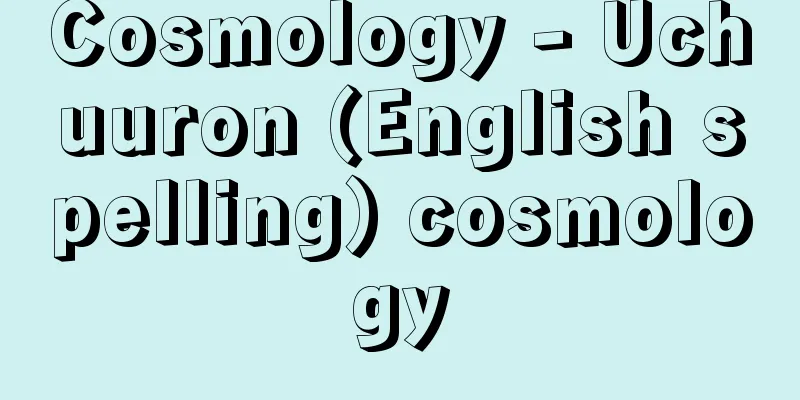Cosmology - Uchuuron (English spelling) cosmology

|
As will be explained later, the universe refers to everything in this world, so all systems of natural philosophy have an aspect of cosmology. Even in "primitive societies," models to explain the structure of the earth on which they live, the existence of the underworld as a place for humans after death, and celestial phenomena are clearly seen. Most generally, however, people who hunt at night have a strong interest in the stars to help them locate themselves, while in cultures that are primarily agricultural, they are primarily interested in the earth and the sun. Each ancient civilization had its own cosmology which it refined from the time of its origins, but the traditions of Sumer, the center of ancient Babylonia, are considered particularly important in that they influenced Greece not only through their mythological cosmology centered on the god Marduk, but also through their meticulous astronomical observations and the development of mathematical methods. As will be described later, the Greek theory of the structure of the universe was extremely sophisticated and produced impressive results in describing celestial phenomena, but the Western view of the universe was formed when the cosmic time image with a clearly defined beginning and end, which is extremely characteristic of Judaism and Christianity, was amalgamated with the Greek theory of the structure of space as the cosmos. This is because in most other cultures, cosmological time always has a recurrent and circular structure. Furthermore, even today, logically speaking, the origin of the universe is either left unquestioned or must be relied upon as something supernatural, and it is necessary to make it clear in advance that even today's scientific cosmology cannot discuss the origin of the universe in the true sense of the word. [Yoichiro Murakami] religious (mythological) cosmologyAccording to the "Qi Zhu Xun" in the "Huainanzi," "Yu" means the four directions of heaven and earth, and "chu" means past, present, and present, and so the universe is a concept that encompasses everything in the spatial and temporal world. Cosmology is the study of the form, origin, and fate of the universe, and in particular, the study of its composition is called "cosmography," while the study of its origin is called "cosmogony," and they are sometimes distinguished from each other. It is thought that humans had some kind of image of the world they live in from an early age, but it was not until the high cultures that appeared in Mesopotamia and other places around several thousand years BC that this image began to be expressed in a more or less coherent form. In these cosmologies, which are usually described in the form of myths, the first theme is the origin of the universe, which can be broadly divided into two types: creation by a superhuman being, and spontaneous generation. The creation theory varies depending on the nature of the creator god (single or multiple, etc.), while the spontaneous generation theory includes stories of the cosmic egg, early man, or the creation from chaos. Alongside this, the shape of the universe is also an important theme. In these theories, there is often a representation of the universe having some kind of center or axis, as well as the idea of its spatial differentiation (for example, the distinction between heaven, earth, and underworld), the latter of which often corresponds to a distinction between the inhabitants of gods, humans, and the dead. Although the contents of religious (mythological) cosmologies are diverse, they share some common features. One is that the physical/natural universe and human beings are not necessarily differentiated but are integrated. Another is that cosmologies are not merely intellectual or theoretical but also fulfill practical functions. For example, the origin of the universe is almost always connected to the origin of human beings themselves. Religious cosmologies do not simply tell us what the world is, but rather give order and meaning to life by locating human beings (groups) within it. Historically, the decline of religious cosmology and its surrender to more rational forms of thinking is a general trend, as exemplified by ancient Greece and India. It was first replaced by philosophical cosmology, and in modern times by scientific cosmology. This can be said to be the result of the universe being separated from humans and objectified, and the differentiation and development of only the intellectual and theoretical elements of cosmology. [Tokuyoshi Tamaru] Scientific CosmologyCosmology is the science that discusses the properties and shape of the universe as a whole. In the past, this "science" was used in the sense of metaphysics, but today it is used in the sense of natural science. This can be compared to the situation where atomic theory was used in a metaphysical sense in the past, a term that was thought up at a stage before the existence of atoms was discovered, but then, in the early 20th century, when atoms became real objects, atomic physics, which could be called a natural science version of atomic theory, was born. However, in the case of cosmology, natural science cosmology is not called astrophysics, but is still called cosmology by the same term, which can easily lead to confusion. [Jun Fujimura] The hierarchy of the universe and astrophysicsToday, when we think of the so-called universe, it is made up of several layers: planetary systems, stars, interstellar matter, galaxies, galaxy clusters, and the whole universe. Each of these layers is qualitatively different, governed by different laws, and when they are treated as natural scientific objects, the approach is naturally different. Of these, the science that deals with the whole universe is called cosmology in a limited sense today. This is not called astrophysics because the term astrophysics was originally given to science that started out as physics dealing with stars, nebulae, galaxy clusters, interstellar matter, etc., and it encompasses a much broader range of objects than just the whole universe. The physics of stars, nebulae, galaxy clusters, etc. belong to each branch of astrophysics. Therefore, if we add cosmology, which deals with the whole universe, to this branch, even though it has a different starting point, then cosmology would be a branch of astrophysics. This view is rather prevalent today. Some may consider space science to be a more appropriate term than astrophysics as it encompasses a wider range of subjects, but for historical reasons, the term space science is often used to mean outer space science, i.e., planetary space science. Therefore, it is not appropriate to call cosmology a branch of space science at present. [Jun Fujimura] Cosmology and cosmologyThe reason for this confusion in terminology is that human speculation about the heavens began as a vague view of the universe, which was gradually expanded from relatively familiar objects, i.e., the observable realm, and each time this scope was called the universe. In other words, the universe that is the subject of science gradually expanded in scope. And it was only after the 20th century that the "entire universe" emerged as a subject of natural science, probably after Einstein applied the theory of general relativity to his studies. The progress of cosmology in this narrow sense has been remarkable, and the content of astrophysics has been rapidly developed. In this sense, cosmology today is a science that investigates the specific natural scientific object of the universe (the entire universe), and is not a type of ideology that assumes a vague universe and discusses its existence metaphysically. However, just as atomic theory as a view of matter is not necessarily unrelated to the various atomic sciences, the concept of the universe that humans first held and the view of the universe are in no way unrelated to today's sciences of the universe, including cosmology, and are in fact one of their sources. In fact, the idea of calling the universe a framework of the world that encompasses all areas and all existence that the human intellect can imagine was probably the starting point of today's sciences of the universe. The effort to regard it as a real, objective world, to distinguish between the heavens and the earth, and to gradually build up a precise view of the universe from the consideration of the heavens gave birth to today's sciences of the universe. There is also an aspect that cannot be denied in the literal meaning of the word and the history of the past that speculative consideration of the existence of the universe in a broad sense is called cosmology. [Jun Fujimura] Contemplation of HeavenFor ancient people, the scope of their actions, and therefore the scope of what they could imagine, was quite limited. That was their world. But at the same time, they knew another world that was different from that world: the heavens. It was a world that was out of their reach, but they could see it. If we call the entire scope of what we can imagine the universe, then the universe can be broadly divided into the heavens and the earth. The heavens are sacred because they are high and deep, and therefore belong to God, while the earth belongs to humans. The Pythagoreans, who attempted to give an intellectual interpretation to the heavens, positioned the celestial bodies on concentric spheres with the earth at the center, and organized the celestial bodies by capturing the laws of their motion in harmony. With the exception of the sun and the moon, the celestial bodies were points of light, and their trajectories were geometric lines. The celestial bodies were a geometrical world rather than a material one. Plato, who searched for a universal principle in the order of the heavens, found it in geometric beauty, and instead of Pythagoras's integer and musical beauty, he made the beauty of the perfect shape of a circle the symbol of heaven. It is the beauty of purified reason, and its worldview has much in common with the beauty of the spiritual world. This geometric depiction of the heavens and the idea of the circle as a fundamental principle were strongly inherited later, and continued to be in the form of Aristotle, who introduced the immaterial substance "ether", completing the theory of the finite universe in the form of a celestial sphere of fixed stars, and further bore fruit as an interpretation of the heavens that does not contradict observations through Ptolemy's geocentric theory based on epicycles and eccentric circles. It should be said to be a sophisticated system based on a complete geometric view of the universe. [Jun Fujimura] Heliocentric theory and infinite universeCopernicus's heliocentric theory (1543) also inherited this geometrical image of the universe and the idea of circles. This situation can be seen from the fact that, in addition to simplifying the description, one of the impetuses of Copernicus' heliocentric theory was his desire to enforce the axiom of circles, due to his dissatisfaction with the fact that the equant introduced by Ptolemy prevented uniform circular motion at a uniform speed. However, the most important significance of the heliocentric theory was, of course, that it established an image of the solar system as a group of planets arranged in an orderly manner with the sun at the center, a new image of the universe. This was because, by positioning the sun as a central entity, instead of the simple dualistic opposition between heaven and earth, that is, the privileged position of the earth, it allowed us to predict the forces acting there, and also led to the discovery of the inertial system in the future. Furthermore, Bruno derived from this the denial of the stellar celestial sphere and the possibility that stars exist at an infinite distance, and discussed the infinite universe and various worlds, along with the fact that the earth has become an ordinary celestial body. This was a major transformation of the view of the universe. The greatest contribution to this change was made by the results of observations made with Galileo's telescope. His discoveries of the unevenness of the moon's surface, sunspots, the phases of Venus, and the moons of Jupiter supported the heliocentric theory, while his discoveries that the size of the stars is much smaller than they appear, and that the galaxy is made up of an infinite number of stars, corroborated the idea of an infinite universe. [Jun Fujimura] The physical universe and the mechanical worldThe establishment of the heliocentric theory started with the image of the sun as the center of forces, and naturally led to a view of the universe in terms of material forces. Kepler's discovery of elliptical orbits (New Astronomeria, 1609; Harmony of the World, 1619) swept away the geometric image based on circles, and Descartes established a view of the universe based on the vortex theory, but it was Newton who explained the movement of celestial bodies by the force acting between materials - the force of universal gravitation - and rewrote the image of the universe with mechanical matter. He gave Kepler's laws by comparing the fall of objects on the earth's surface with the movement of the moon, and by considering celestial bodies such as the moon to be equivalent to objects on Earth, he reduced the movement of celestial bodies to a problem of mechanics (Principia, 1687). The solar system became a problem of mechanics, and with the development of celestial mechanics, a view of the universe composed of mechanical matter based on a mechanistic view of nature was established. Meanwhile, the origin of the solar system also came to be understood as a scientific explanation, for example with the appearance of the Kant-Laplace nebular theory. This mechanical picture of the universe was further solidified by the discovery of binary stars, which demonstrated that Newtonian mechanics also applied to the stellar world studied in the early 19th century. [Jun Fujimura] Expanding the boundaries of the universe and discovering its structureThe discovery of the island universe (extragalactic objects) by F. W. Herschel marked a turning point in the depiction of the universe. He focused on the movement of stars and tackled the problem of their grouping (stellar system), discovered that the Milky Way in the night sky is a grouping of stars, and proposed a model of our galaxy, including the solar system (1785). The later discovery that the solar system is never located near the center of the galaxy can be said to have played a role as a second heliocentric theory. By the end of the 18th century, Herschel had discovered groups of stars other than our galaxy, that is, other galaxies. The expansion of the boundaries of the universe was confirmed in the 19th century with the advancement of observational methods such as spectroscopic observations and the Doppler effect, and the discovery of many new galaxies. Quantitative determination of distances also progressed from Bessel's determination of stellar distances using parallax to the determination of galaxy distances using Cepheid variables. This was the discovery of the structure of the universe. [Jun Fujimura] Expanding UniverseOn the other hand, by determining the radial velocity of stars and galaxies using the Doppler effect, it was discovered that they were all moving away from each other, i.e., that the universe was expanding. The presentation of Hubble's law, which showed that the speed at which they are moving away is roughly proportional to the distance to the galaxy, demonstrated the uniformity of the universe and transformed the picture of the universe from a static one to a dynamic one. Today's cosmology is a branch of scientific research that deals with the entire expanding universe. [Jun Fujimura] The advent of general relativityThe foundation of a scientific theory covering the entire universe was provided by Einstein's general theory of relativity (1916). This is because the typical application of this theory, which can handle global objects, is to deal with the behavior of the entire universe. Einstein himself gave a solution for the static universe, but later, A. A. Friedman and others obtained a solution for the expanding universe, and the general theory of relativity rapidly gained power as the basis of cosmology. This is because the discovery of Olbers' paradox and Hubble's law supported the expanding universe. In this situation, the theory of the evolution of the universe through the Big Bang proposed by Gamow around 1950 became influential, and especially after the discovery of the cosmic microwave background radiation (3K radiation) by Penzias and R. W. Wilson (1965), the idea of the creation of the universe through the Big Bang and its evolution came to be adopted, and the steady state theory, which attempts to view the universe as stationary, faded into obscurity. [Jun Fujimura] Progress in observation and development of the expanding universe theorySince the 1960s, along with improvements in the precision of instruments, new observational methods other than visible light (radio waves, X-rays, gamma rays, infrared rays, neutrinos, gravitational waves, etc.) have been introduced one after another, and observational data has been accumulated, diversified, and refined. The uniform density distribution of galaxies and dark matter in the universe, the current decelerating expansion of the universe, and the particle horizon (the observed size of the universe) being approximately 15 billion light years are basic knowledge in today's cosmological models. Along with this, the theoretical content of the expanding universe has also progressed, and in the early 1980s, Katsuhiko Sato (1945- ) and Alan Harvey Guth (1947- ) proposed the inflationary universe. This theory posits that there was a rapid accelerating expansion (inflationary expansion) at the beginning of the universe, and it successfully explains the uniformity of the observed cosmic microwave background radiation (microwave blackbody radiation with a temperature of 3K) and the causality problem related to the particle horizon (the particle horizon difficulty), as well as the problem of the flatness of the universe being infinitely flat, and also avoids the difficulty of magnetic monopoles pointed out in relation to the Grand Unified Theory (GUT) of particle physics. Nevertheless, the idea of the inflationary universe, in which the universe began in a vacuum state and a phase transition due to interactions with gravity led to the formation of a primordial fireball, requires the construction of a quantum gravity theory on which it is based. [Jun Fujimura] Towards the advancement of cosmologyOne of the important problems that the inflation theory has left unresolved is the problem of the creation of the universe. When tracing the current expansion of the universe back to its beginning, we must imagine an infinite mass with infinite temperature in a volume of zero. This is a "singularity" that is beyond the scope of the laws of physics, and this situation makes the problem of the creation of the universe an extremely difficult problem in cosmology. Here, the problem is, so to speak, "creation from nothing." Attempts to solve this include the idea of Alexander Vilenkin (1949- ), who believes that the universe was born from the "fluctuation" of nothing through the tunnel effect, and Hawking, who introduced the "no boundary hypothesis" that the universe began as an imaginary time, in order to eliminate the singularity. Other attempts have been made to explain this from superstring theory (also called superstring theory or superstring theory), and efforts to solve the problem have been made, including the proposal of the theory of the brane world. If we are to pursue the creation of the universe from the perspective of quantum theory, a theory that treats space-time in quantum mechanical terms is essential, but this has not yet been established. Furthermore, there is still no clear future for research aiming for a so-called "super grand unified theory," which would incorporate gravity into the current grand unified theory and unify the four fundamental forces that exist in nature (strong force, electromagnetic force, weak force, and gravity). The integration of quantum theory and general relativity, which are considered to be incompatible with each other, is likely to be a challenge for 21st century physics. [Jun Fujimura] "Ancient Cosmology" edited by C. Brucker and M. Rowe, translated by Yajima Yuri and Yajima Fumio (1976, Kaimeisha)" ▽ "Modern Cosmology" edited by Laurie H. Jones, translated by Oobi Shinya and Takebe Naoo (1977, Kaimeisha)" ▽ "Myth and Thought of the Ancient Orient - Pre-Philosophy" by H. Frankfort, translated by Yamamuro Shizuo and Tanaka Akira (1978, Shakaishisosha)" ▽ "Time and Space in the Universe" by P.C.W. Davies, translated by Toda Morikazu and Tanaka Hiroshi (1980, Iwanami Shoten)" ▽ "The Discovery of the Big Bang - An Introduction to Cosmology" by Sato Fumitaka (1983, NHK Publishing)" ▽ "The Progress of Cosmology" by J. Sharon, translated by Nakayama Shigeru (1983, Heibonsha)" ▽ "The Complete History of Cosmology" by E. Rosen and L. Motz, translated by Jun Kikuchi and Seiichiro Sugiyama (1987, Heibonsha)" ▽ "Crossing Borders in Cosmology: The Limits of Science" by Richard Morris, translated by Shunsuke Matsuura (1991, Seidosha)" ▽ "The Age of the Galaxy: A Natural History of Cosmology, Volumes 1 and 2, by Timothy Ferris, translated by Haruyo Nomoto (1992, Kousakusha)" ▽ "All About Cosmology" by Ryo Ikeuchi (1998, Shinshokan)" ▽ "The Collapse of the Cosmos: From a Closed World to an Infinite Universe" by A. Koyle, translated by Kyo Nozawa, newly reprinted (1999, Hakusuisha)" ▽ "Cosmology Today," edited by the Parity Editorial Committee (2003, Maruzen)" ▽ "The Historical Evolution of Cosmology by Arrhenius, translated by Torahiko Terada (Iwanami Bunko)" ▽ "The World of Galaxies" by Hubble, translated by Ebisuzaki Shunichi (Iwanami Bunko)" ▽ "An Invitation to Cosmology - Principia and the Big Bang" by Sato Fumitaka (Iwanami Shinsho)" ▽ "Understanding Cosmology" by Kuroboshi Eiichi (Kodansha Gendai Shinsho)" ▽ "The Modern Image of the Universe" by Sato Fumitaka (Kodansha Academic Library)" ▽ "X-Ray Astronomy" by Oda Minoru (1975, Chuokoron-Shinsha)" ▽ "The Universe and Physics" edited by the Physical Society of Japan (1983, Baifukan)" ▽ "Elementary Particle Physics - From Quarks to the Universe" edited by the Parity Editorial Committee (1988, Maruzen)" ▽ "Modern Cosmology" edited by Hayakawa Yukio et al. (1988, Nagoya University Press)" ▽ "Parity Physics Course: Relativistic Cosmology" by Kodama Hideo (1991, Maruzen)" ▽ "The Modern Image of the Universe," edited by the Physical Society of Japan (1991, Baifukan)" ▽ "Iwanami Lectures on Modern Physics 6: General Theory of Relativity, by Sato Fumitaka and Kodama Hideo (1992, Iwanami Shoten)" ▽ "Why Did the Big Bang Occur? - The Origin of the Universe Revealed by Inflation Theory, by Alan H. Guth, translated by Hayashi Hajime and Hayashi Masaru (1999, Hayakawa Publishing)" ▽ "Astrophysics, by Sato Fumitaka (2001, Iwanami Shoten)" ▽ "Cosmology in Matter, by Naganaga Naoto (2002, Iwanami Shoten)" ▽ "Hawking Discusses the Universe - From the Big Bang to Black Holes, by Stephen W. Hawking, translated by Hayashi Hajime (Hayakawa Bunko)" [References] | | | | | | | | | | | | | | | | | | | | | | | | | | |Elementary | | theory| | | | | | | | | | | | | | | | | | | | | | | | | |Source: Shogakukan Encyclopedia Nipponica About Encyclopedia Nipponica Information | Legend |
|
宇宙とは、後述のように、この世界いっさいのことをいうのであるから、あらゆる自然哲学の体系は、宇宙論の様相を帯びることになる。「未開社会」にも、自らの住む大地の構造や、人間の死後の世界としての冥府(めいふ)の存在、天空の現象を説明するためのモデルなどは明確にみられる。もっともごく一般的にいえば、夜間狩猟を行う民族には、位置確認のために、星辰(せいしん)への関心が強く、農耕主体の文化にあっては、大地と太陽とが関心の主体になる。 古代文明は、発祥時からそれぞれに宇宙論をもち、洗練化しているが、なかでも、古代バビロニアの中心であるシュメールの伝統は、マルドゥクという神を中心とした神話的宇宙生成論ばかりでなく、克明な天体観測と数学的手法の開発によって、ギリシアに影響を与えたという点で重要視されている。 ギリシアでの宇宙構造論は、後述のように精緻(せいち)を極めたもので、天体現象の記述にもみごとな成果をあげたが、ユダヤ・キリスト教においてきわめて特徴的な、始点と終点を明確に定めた宇宙的な時間像と、コスモスとしてのギリシア的な空間構造論とがアマルガム化したところに西欧的宇宙観の形成がある。というのも、他のほとんどの文化圏において、宇宙論的時間はつねに回帰的かつ円環的な構造をもつからである。また宇宙の発祥については、論理的にいって、不問に付すか、超自然的な何ものかに頼らざるをえないという事情は今日でもあり、今日の科学的宇宙論といえども、真の意味での宇宙の発祥を論ずることはできない点は、あらかじめ確認しておく必要があろう。 [村上陽一郎] 宗教(神話)的宇宙論『淮南子(えなんじ)』「斉俗訓(せいぞくくん)」によれば、宇は天地四方、宙は古往今来の義とされているごとく、宇宙とは、空間的、時間的な世界のいっさいを包括する概念である。その宇宙の形態、生成、運命などについて考察するのが宇宙論であるが、なかでもその構成を扱うものを宇宙形態論cosmography、また起源を論ずるものを宇宙生成論cosmogonyとよび、区別することもある。 人間がその住む世界について、早くからなんらかのイメージを抱いていたことは考えられるが、それがある程度まとまった形で表現されるようになるのは、紀元前数千年ごろ、メソポタミアをはじめ各地に出現した高文化以後のことである。普通、神話の形で述べられるこれら宇宙論では、まず宇宙の起源が主題とされるが、それには大別して、超人間的存在による製作・創造と、自然発生という二つの型がある。創造説は創造神の性格(単独か複数かなど)による変様があり、自然発生説には宇宙卵や原人、ないし混沌(こんとん)からの成立譚(たん)などが含まれる。これと並んで、宇宙の形態も重要な主題をなす。その際しばしばみられるのは、宇宙がなんらかの中心、軸をもつという表象、ならびにその空間的分化(たとえば天界、地上、地下の区別)の考えであり、後者には神々、人間、死者という住者の区別が対応することが多い。 宗教(神話)的宇宙論の内容は多様であるけれども、それらにはいくつか共通した特徴が認められる。一つは、物理的・自然的宇宙と人間とがかならずしも分化せず、融即(ゆうそく)していることであり、他は、宇宙論が単に知的、理論的なものにとどまらず、同時に実践的な機能を果たしていることである。たとえば宇宙の起源は、ほとんどつねに人間自らの起源と結び付けて語られる。そして宗教的宇宙論は、ただ世界が何であるかを告げるのではなく、そのなかに人間(集団)を位置づけることで、生に秩序と意味とを与えるのである。 歴史的にみると、こうした宗教的宇宙論が没落し、より合理的な思考形式に所を譲ることは、古代ギリシアやインドに例証される一般的傾向である。それはまず哲学的宇宙論に、そして近代以後はさらに科学的宇宙論によって置き換えられてきた。これは、宇宙が人間から切り離されて対象化されるとともに、宇宙論のなかの知的、理論的な要素のみが分化、展開したものといえよう。 [田丸徳善] 科学的宇宙論宇宙論とは宇宙全体の性質、形状などを論ずる学である。かつてはこの「学」の意味は形而上(けいじじょう)学の意味で用いられたが、今日では自然科学の意味で用いられるようになった。ちょうど原子論が、古くは形而上学的な意味で用いられ、原子という実在がみいだされる以前の段階で考えられる用語であったのに対し、20世紀初頭から原子が現実の対象となるに及んで、自然科学的な原子論とでもいうべき原子物理学が誕生した事情と類比されよう。しかし宇宙論の場合には、自然科学的宇宙論を宇宙物理学といわず、やはり同じ用語で宇宙論とよんでいるため混乱を招きやすい面がある。 [藤村 淳] 宇宙の階層と宇宙物理学今日、いわゆる宇宙を考えるとき、それはいくつかの階層から成り立っている。すなわち、惑星系、恒星、星間物質、銀河、銀河集団、そして全宇宙などである。これらの諸階層はそれぞれに質的に異なった存在であり、異なった法則が支配し、自然科学的な対象として扱うとき、おのずからアプローチの方法が異なっている。これらのうち、とくに「全宇宙」を対象として扱う科学が、今日、限定された意味でいわれる宇宙論である。これを宇宙物理学といわないのは、宇宙物理学という用語が、もともと恒星、星雲、銀河集団、星間物質などを扱う物理学として出発した科学に与えられた名称であり、全宇宙という対象のみではないもっと広い対象を包括しているからである。恒星、星雲、銀河集団などの物理学はこの宇宙物理学の各分科に属する。それゆえ、その出発点を異にしているが、全宇宙を扱う宇宙論もここに加えるとすれば、宇宙論は宇宙物理学の一分科ということになろう。今日ではむしろこのような見方が多く行われている。 広い対象を包括する用語としては宇宙物理学よりも宇宙科学のほうが妥当とする見解もありうるが、これも歴史的ないきさつにより、宇宙科学という用語は宇宙空間科学、すなわち惑星空間科学の意味で用いられることが多い。したがって宇宙論を宇宙科学の一分科とよぶことは現状では適切でない。 [藤村 淳] 宇宙観と宇宙論このように用語上の混乱が生じたのは、天界に関する人間の思索が、初め漠たる宇宙観として始まり、それが比較的身近な対象、つまり観測可能な領域から逐次解明の過程を進め、そのつどその範囲を宇宙とよんでいったという事情がある。いわば科学の対象となる宇宙は逐次その領域を拡張していったのである。そして「全宇宙」が自然科学の対象として登場したのは20世紀以後のことに属し、アインシュタインが一般相対性理論を適用して考察した時期以降とみるべきであろう。この狭義の意味での宇宙論の進歩は目覚ましく、宇宙物理学としての内容を急速に整えてきた。 今日いう宇宙論はこのような意味で宇宙(全宇宙)という自然科学的な特定の対象を考究する科学であり、漠然とした宇宙を想定してその存在を形而上学的に論ずる一種の思想なのではない。 しかし物質観としての原子論が原子の諸科学とかならずしも無縁でないように、初めに人間が抱いた宇宙の概念そのものや、また宇宙観は、宇宙論を含む今日の宇宙の諸科学とけっして無縁ではなく、むしろその源泉の一つとなっている。実際、人間の知性が想定しうる全領域、あらゆる存在をすべて包括する世界の枠組みを宇宙とよぶ発想は、今日の宇宙の諸科学の出発点をなしたものであっただろう。それを実在する客観的世界とみなし、そこに天界と地上界を区別し、天界に対する考察からしだいに精密な宇宙観を築き上げてゆく努力が、今日の宇宙の諸科学を誕生させたのである。宇宙観を中心に、広く宇宙の存在様式に対し思弁的な考察を加えることを宇宙論とよぶことも、ことばの文字どおりの字義や過去のいきさつからして、否定できない一面をもっているであろう。 [藤村 淳] 天界への思索古代人にとってその行動できる範囲、したがって想定できる範囲はかなり限られていた。それが彼らの世界であった。しかし同時に彼らは、その世界とは異なるもう一つの世界を知っていた。天界である。彼らの手には届かない世界であったが目には映じた。想定しうるすべての範囲を称して宇宙とよぶとすれば、ここで宇宙は天界と地上界に大別される。天界は高く深くきわまりないゆえに聖であり、神に属し、大地は人間に属した。 天界に知的な解釈を試みたピタゴラス学派は、大地を中心とする同心球上に天体を位置づけ、天体の運行の法則をハーモニーのなかにとらえることで天体を秩序づけた。日と月を除けば天体は光点であり、その軌跡は幾何学的な線である。天体は物質的なものであるよりは幾何学的な世界であった。 天体の秩序のなかに普遍原理を模索したプラトンは、幾何学的美のなかにその原理を発見し、ピタゴラスの整数的・音楽的な美にかえて、円という図形の完全さという美を天を象徴するものとした。それは純化された理性の美であり、その世界像は多分に精神的世界の美と共通性をもっている。天界に対するこの幾何学的描像と基礎原理としての円という思想は、その後に強く受け継がれ、非物質的な物質「エーテル」を導入したアリストテレスにおいてもその形を保ち、恒星天球という有限宇宙論を完成させ、さらにプトレマイオスの周転円、離心円に基づく天動説によって観測と矛盾しない天界の解釈として実を結んだ。完結された幾何学的宇宙観による精緻(せいち)な体系というべきであろう。 [藤村 淳] 地動説と無限宇宙コペルニクスの地動説(1543)もまた、この幾何学的宇宙像と円の思想を受け継ぐものであった。この事情は、実際、記述の単純化ということと並んで、プトレマイオスが導入したエカントが一様な等速円運動を妨げることへの不満から、円の公理を貫徹させようと望む意図がコペルニクスの地動説の一つの契機になったことからうかがわれる。しかし地動説の重要な意義は、いうまでもなく、太陽を中心として整然と配列された惑星群という太陽系の像、新しい宇宙像を打ち立てたことであった。これは、天と地という単純な二元的対立関係、すなわち地球の特権的地位にかえて、中心的存在としての太陽を位置づけることで、そこに働く力を予想させるもの、あるいは将来、慣性系の発見を先導するものとなったからである。さらにブルーノはここから恒星天球の否定と恒星が無限の距離に存在する可能性を引き出し、地球がありふれた一天体となったこととあわせて無限宇宙と諸世界を論じた。宇宙観はここで大きな変貌を遂げることとなる。そしてこの変革に大きな功績があったのはガリレイの望遠鏡を用いての観測結果であった。月表面の凹凸、太陽の黒点、金星の満ち欠け、木星の衛星の発見は地動説を支持し、恒星の大きさが見かけよりはるかに小さいこと、および銀河が無数の星でできていることの発見は無限宇宙を裏づけることとなった。 [藤村 淳] 物質的宇宙と力学的世界太陽中心説の確立は、力の中心としての太陽という描像に始まり、おのずから宇宙を物質的な諸力によってみる方向へ進展させるものであった。ケプラーの楕円(だえん)軌道の発見(『新天文学』1609、『世界の調和』1619)は、円を基礎としていた幾何学的描像を一掃し、またデカルトは渦動説による宇宙像を樹立したが、物質間に働く力――万有引力によって天体の運動を説明し、力学的物質によって宇宙像を書き換えたのはニュートンである。彼は地表上での物体の落下と月の運動を対比し、月のような天体も地球上の物体と同等とみなすことによってケプラーの法則を与え、天体運動を力学の問題に還元した(『プリンキピア』1687)。太陽系は力学の問題となり、天体力学の進展とともに、機械論的自然観に基づく力学的物質によって構成される宇宙という描像が樹立された。一方、太陽系の成因についても、たとえばカント‐ラプラスの星雲説が登場してその科学的解明が意図される状況となった。そしてこの力学的宇宙像は、やがて19世紀初めに研究された恒星の世界でもニュートン力学が成り立つことを示す連星の発見によって、いっそう確かなものとなった。 [藤村 淳] 宇宙の枠の拡大と構造の発見宇宙の描像に一転期を画したのは、F・W・ハーシェルによる島宇宙(銀河系外天体)の発見である。彼は恒星の運動に注目してその集団(恒星系)の問題に取り組み、夜空にかかる天の川が恒星の集団であることをみいだし、太陽系を含むわれわれの銀河のモデルを提出した(1785)。のちに太陽系がけっして銀河の中心付近にはないことが判明したことは、第二の地動説の役割を果たしたものといえよう。18世紀の末までにハーシェルは、われわれの銀河以外の星の集団、すなわち他の銀河を発見していた。そしてこの宇宙の枠の拡大は、19世紀に入って分光学的観測やドップラー効果などによる観測手段の進歩とともに新たな数多くの銀河の発見という形で確定された。距離の定量的決定も、ベッセルによる視差を用いた恒星の距離決定から、ケフェウス型変光星を手掛りにする銀河の距離の決定へと進んだのである。これは宇宙の構造の発見であった。 [藤村 淳] 膨張宇宙一方、ドップラー効果による恒星、銀河などの視線速度の決定からは、それらがいずれも遠ざかりつつあること、すなわち宇宙が膨張しつつあることが判明した。その遠ざかる速度がほぼ銀河までの距離に比例することを示したハッブルの法則の提示によって、宇宙の一様性が示されるとともに、宇宙の描像は静的なものでなく、動的なものへと転換された。今日の宇宙論は、この膨張しつつある全宇宙を対象とする科学研究の一分科なのである。 [藤村 淳] 一般相対性理論の登場全宇宙を対象とする科学理論の基礎は、アインシュタインの一般相対性理論(1916)によって与えられた。大域的対象を扱うことができるこの理論の典型的な適用は全宇宙のふるまいの取扱いだからである。アインシュタイン自身は静的宇宙の解を与えたが、その後、A・A・フリードマンらによって膨張宇宙の解が得られ、宇宙論の基礎として一般相対性理論は急速に力を増した。オルバースの背理やハッブルの法則の発見は、膨張する宇宙を裏づけていたからである。この状況のなかで1950年前後にガモフが提唱したビッグ・バンによる宇宙の進化説が有力となり、とりわけ、ペンジアスとR・W・ウィルソンによる宇宙背景放射(3K放射)の発見(1965)以降は、ビッグ・バンによる宇宙生成とその進化という考えが採用されるに至り、宇宙を定常的にとらえようとする定常宇宙論は影を潜めることとなった。 [藤村 淳] 観測の進展と膨張宇宙論の展開1960年代以降、装置の精度の向上とともに、可視光以外の新たな観測手段(電波、X線、γ(ガンマ)線、赤外線、ニュートリノ、重力波など)も次々と導入されて、観測データの蓄積が進み、その内容は多様化、精密化した。宇宙における銀河と暗黒物質(ダークマター)との一様な密度分布や、現在の宇宙膨張が減速的なものであること、粒子的地平線(観測される宇宙の大きさ)がほぼ150億光年であることなどは、今日の宇宙モデル考察の基本的な知見となっている。これに伴って膨張宇宙の理論的な内容付けも進み、1980年代初頭には佐藤勝彦(かつひこ)(1945― )やアラン・グースAlan Harvey Guth(1947― )によるインフレーション宇宙の提唱もあった。これは宇宙の始まりの初期に急速な加速度的膨張(インフレーション膨張)があったとするもので、観測される宇宙背景放射(温度3Kのマイクロ波黒体放射)の一様性と粒子地平線にかかわる因果性の問題(粒子地平線の困難)や、宇宙が限りなく平らに近いという平坦性の問題がうまく説明され、また素粒子物理の大統一理論Grand Unified Theory(GUT)との関連で指摘される磁気モノポール(磁気単極子)の困難も回避された。とはいえ、宇宙が真空状態から始まり、重力との相互作用による相転移が原始火の玉の形成をもたらしたとするインフレーション宇宙の考えには、その基礎となるべき量子重力論の建設がまたれる。 [藤村 淳] 宇宙論の進展に向けてインフレーション理論も積み残した重要な課題の一つに、宇宙創生の問題がある。膨張してきた現在の宇宙を逆にたどってその始原にさかのぼってゆくとき、体積ゼロのなかに無限大の温度をもつ無限大の質量が想定されねばならない。これはいわば物理法則の成立の埒(らち)外にある「特異点」であり、この事情は、宇宙創生の問題を宇宙論におけるきわめて困難な問題点としている。ここでは、いわば「無からの創生」が課題となるからである。これを解決する試みとしては、無の「ゆらぎ」からトンネル効果によって宇宙が生まれるとするビレンキンAlexander Vilenkin(1949― )の考えがあり、またホーキングは宇宙が虚数の時間として始まるとする「無境界仮説」を導入して特異点の消去を図った。ほかに超ひも理論(超弦理論もしくはスーパーストリング理論ともいう)からの説明も試みられ、ブレーンワールド(膜宇宙)の理論の提唱もあって解決への努力が重ねられている。 宇宙の創世を量子論の立場から追求しようとする限り、時空を量子力学的に取り扱う理論が必須(ひっす)であるが、これは未成立である。そして、現在の大統一理論にさらに重力をも組み込んで自然界に存在する基本的な四つの力(強い力・電磁力・弱い力・重力)を統一しようとする、いわば「超大統一理論」を目ざす研究の方向にも、まだ前途はみえていない。お互いになじみがたいとされる量子論と一般相対論との統合は、まさに21世紀物理学の課題なのであろう。 [藤村 淳] 『C・ブラッカー、M・ローウェ編、矢島祐利・矢島文男訳『古代の宇宙論』(1976・海鳴社)』▽『ローリー・H・ジョーン編、小尾信彌・武部尚雄訳『現代の宇宙論』(1977・海鳴社)』▽『H・フランクフォート著、山室静・田中明訳『古代オリエントの神話と思想――哲学以前』(1978・社会思想社)』▽『P・C・W・デイヴィス著、戸田盛和・田中裕訳『宇宙における時間と空間』(1980・岩波書店)』▽『佐藤文隆著『ビッグバンの発見――宇宙論入門』(1983・日本放送出版協会)』▽『J・シャロン著、中山茂訳『宇宙論の歩み』(1983・平凡社)』▽『E・ローゼン、L・モッツ著、菊池潤・杉山聖一郎訳『宇宙論全史』(1987・平凡社)』▽『リチャード・モリス著、松浦俊輔訳『越境する宇宙論――科学の極限』(1991・青土社)』▽『ティモシー・フェリス著、野本陽代訳『銀河の時代――宇宙論博物誌』上下(1992・工作舎)』▽『池内了著『宇宙論のすべて』(1998・新書館)』▽『A・コイレ著、野沢協訳『コスモスの崩壊――閉ざされた世界から無限の宇宙へ』新装復刊(1999・白水社)』▽『パリティ編集委員会編『宇宙論はいま』(2003・丸善)』▽『アレニウス著、寺田寅彦訳『史的に見たる宇宙観の変遷』(岩波文庫)』▽『ハッブル著、戎崎俊一訳『銀河の世界』(岩波文庫)』▽『佐藤文隆著『宇宙論への招待――プリンキピアとビッグバン』(岩波新書)』▽『黒星瑩一著『宇宙論がわかる』(講談社現代新書)』▽『佐藤文隆著『現代の宇宙像』(講談社学術文庫)』▽『小田稔著『X線天文学』(1975・中央公論社)』▽『日本物理学会編『宇宙と物理』(1983・培風館)』▽『パリティ編集委員会編『素粒子物理――クォークから宇宙まで』(1988・丸善)』▽『早川幸男他編『現代の宇宙論』(1988・名古屋大学出版会)』▽『小玉英雄著『パリティ物理学コース 相対論的宇宙論』(1991・丸善)』▽『日本物理学会編『現代の宇宙像』(1991・培風館)』▽『佐藤文隆・小玉英雄著『岩波講座現代の物理学6 一般相対性理論』(1992・岩波書店)』▽『アラン・H・グース著、はやしはじめ・はやしまさる訳『なぜビッグバンは起こったのか――インフレーション理論が解明した宇宙の起源』(1999・早川書房)』▽『佐藤文隆著『宇宙物理』(2001・岩波書店)』▽『永長直人著『物質の中の宇宙論』(2002・岩波書店)』▽『スティーヴン・W・ホーキング著、林一訳『ホーキング、宇宙を語る――ビッグバンからブラックホールまで』(ハヤカワ文庫)』 [参照項目] | | | | | | | | | | | | | | | | | | | | | | | | | | | | | | | | | | | | | | | | | | | | | | | | | | | | | | | |出典 小学館 日本大百科全書(ニッポニカ)日本大百科全書(ニッポニカ)について 情報 | 凡例 |
Recommend
Blue Mountains
A full-length novel by Ishizaka Yojiro. It was se...
"Aoto Fujitsuna Moryoan" - Aoto Fujitsuna Moryoan
...He is famous for the story in Volume 35 of the...
Scooter - sukuota (English spelling) scooter
A type of two-wheeled vehicle. It can also be see...
NATURAL
A manga by Narita Minako. A coming-of-age drama de...
Turks and Caicos Islands
Located at the southeastern end of the Bahamas in ...
Swimming
It means to move freely on the surface, underwate...
Rudolf [I] - Rudolf
The first German king of the House of Habsburg (re...
Wound hormone - Wound hormone
〘Noun〙 (Hormon) A general term for hormonal substa...
Djongkha
...the classification name and main distribution ...
Beauty under the tree - Jukabijinzu
A folding screen painting from the Nara period hou...
Ion exchange membrane
A membrane with ion exchange function. It is also...
Grand Trianon (English spelling)
…The king's apartments were positioned as the...
Theory of currency
…He criticized the metallurgical theory of money ...
Ranunculus nipponicus var. major - Ranunculus nipponicus var. major
A perennial aquatic plant of the Ranunculaceae fam...
Hypsibius augusti (English spelling) Hypsibiusaugusti
…The long-finned water bug Macrobiotus hufelandii...





![Shiroishi [city] - Shiroishi](/upload/images/67cbe6c887cb8.webp)



